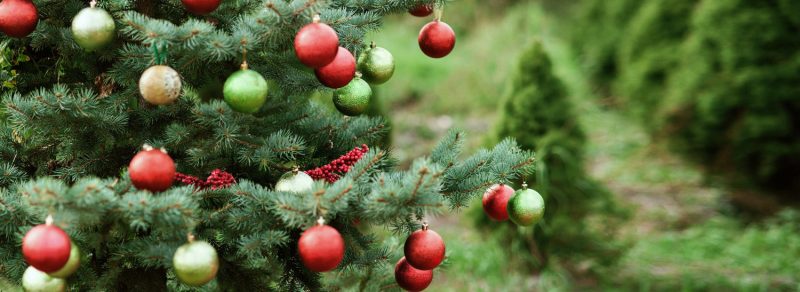
A real Christmas tree on a Christmas tree farm.
Evergreen trees have been celebrated since ancient times, in celebration of the winter solstice, life and vitality. It was likely Germany, though, that first incorporated evergreen trees into the Christian holiday of Christmas. However, the now popular symbol of the holiday season did not become popularly accepted into United States culture until the late 19th and 20th centuries – strict Puritan tradition had attempted to stamp out the incorporation of the Christmas tree at first.
Since then, decorating evergreen trees has become an important part of the Christmas tradition around much of the world. And, in the late 20th century, artificial Christmas trees became popular in American culture.
The debate on whether to get a real or artificial Christmas tree has been a long-standing, deeply entrenched feud for most people in the U.S. Whether it’s because of the nostalgia or intensity associated with holiday traditions, the real/artificial tree issue is one on which most have a passionate opinion.
I am no exception to that, and in my completely biased opinion, real Christmas trees are undoubtedly superior. However, I recognize that my authority – and lack thereof – should not be the sole reason people decide what type of tree to purchase. Here are some reasons real Christmas trees are the superior way to decorate for the holidays.
One argument proponents of artificial Christmas trees wield is that they’re saving a tree by not cutting one down every year. However, cutting down a tree at a Christmas tree farm has a lower environmental impact than their plastic imposters.
Most artificial trees are made with polyvinyl chloride (PVC) that releases carcinogens during the manufacturing and disposal process of the trees. Additionally, the majority of artificial trees aren’t recyclable and end up in a landfill.
Converse to what some may think, shoppers are not eliminating a tree from the earth, or cutting a wild one down. Real trees are grown on tree farms, where they are grown specifically to be cut down – with new trees being planted in their place. During the raising of Christmas trees, they do what all trees do best – eliminate carbon dioxide from the air and release oxygen. When it comes time to dispose of real Christmas trees, the majority are often used for composting or recycled into mulch.
While carbon emissions from artificial and real trees equal out after about 10 years of owning an artificial tree, real trees still win out in terms of environmental impact during the disposal process.
Another argument artificial tree lovers may use is that it is cheaper to buy a fake tree. In reality, artificial trees are not all that more cost effective than their real counterparts.
While anyone can buy a cheap, shaudy artificial tree from a big box store, quality artificial trees can cost nearly $200. Conversely, one can find a real tree that fits their specific demands anywhere from $30-$80 on average. While neither option is truly budget friendly, neither type of tree is significantly more cost effective than the other.
Yes, the needles of real trees can be toxic if eaten by your beloved pets. To this issues I say: be a responsible pet owner. Use a small gate to surround the tree and keep your pets from eating the needles or keep the door to the room your tree is in closed from your pets while you are not in there with them. As well, you can purchase pet-friendly repellent spray to use on the tree and keep your furry family members from chewing on it. There is no reason a love for pets and a love for real Christmas trees should be mutually exclusive – just make sure you are properly taking care of both.
An additional danger that accompanies a real Christmas tree is the possible fire hazard they may become. If left unwatered, the dry tree is more likely to catch fire. Again, responsibility comes into play in this situation. As long as one regularly waters their tree, the likelihood it will catch fire is diminished.
Beyond the logistical benefits to purchasing a real tree over an artificial one, real trees add more Christmas spirit to the holiday season. There is nothing like the smell of an evergreen tree. While real trees may take a bit more effort to maintain – what with vacuuming up the needles and watering the tree – nothing worthwhile comes without effort. As well, vacuuming is a chore that should probably be done more often than most accomplish the task. What better than a Christmas tree to remind you to keep your house clean?
Let’s not forget about the tradition of it all. Going to a Christmas tree farm is an annual tradition for most – one that kicks off the season. Spending a day with family picking out, taking home, and decorating the perfect tree is an event from which no one should miss out. Not to mention, by purchasing from a local Christmas tree farm you are supporting your own community and the producers within it – not some big corporation that mass produces artificial trees.
Whether it’s for the smell, tradition, environmental or economic benefits, it is quite clear that real trees reign supreme against their artificial imposters. Make the decision to either begin or continue a family tradition by going to a local Kansas City area Christmas tree farm and picking out your family’s perfect Christmas tree.
Photo courtesy of Wolf Cove Inn.
